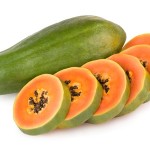 The Power of Papaya
The Power of Papaya
I find the fruits that are available in the wintertime often are lacking in the flavor and texture department. While apples, bananas, and pears fare pretty well, the more color-filled, nutritious ones like strawberries, peaches, and watermelon truly leave me longing for their full goodness found only during the summer months. Recently I came across a delicious and highly nutritious fruit in the produce aisle which had been a long time favorite of mine, but somehow slipped off my radar—papaya!
When I was a young girl, my aunt had a shelf in her kitchen pantry filled with supplements. One bottle caught my attention, as it was filled with pretty, salmon-colored caplets. When I opened the bottle (no childproof caps back then) and took a sniff—the most delightful, fruity scent filled my nostrils. Its label stated that it was a digestive help made from the papaya—a fruit I had not yet seen or tasted. Only after I snuck one out of the bottle and chewed it up, did I ask for permission to do so. And when that permission was given I happily chewed up a second one!
As the bottle on my aunt’s shelf purported, the papaya is indeed a digestive aid. It contains fiber which prevents constipation, and the enzyme, papain, which is known to heal intestinal infections and to assist in the natural digestive process by breaking down proteins into their individual amino acids.
Papayas are also loaded with powerful anti-oxidants such as vitamins A. E, and beta-carotene which improve the health of the eyes and skin, lower cholesterol levels in the body, and act to slow down the aging process as well as providing protection against cancer.
Buy a papaya whose skin is half green/half yellow, place it on the counter for a few days until the skin begins to wrinkle a bit, turning predominantly yellow, and its flesh yields to gentle pressure. When ripened, slice down the middle, lengthwise, scoop out the pits with a spoon, and either skin carefully with a paring knife or slice crosswise, like a watermelon, and eat it directly from the rind/skin.